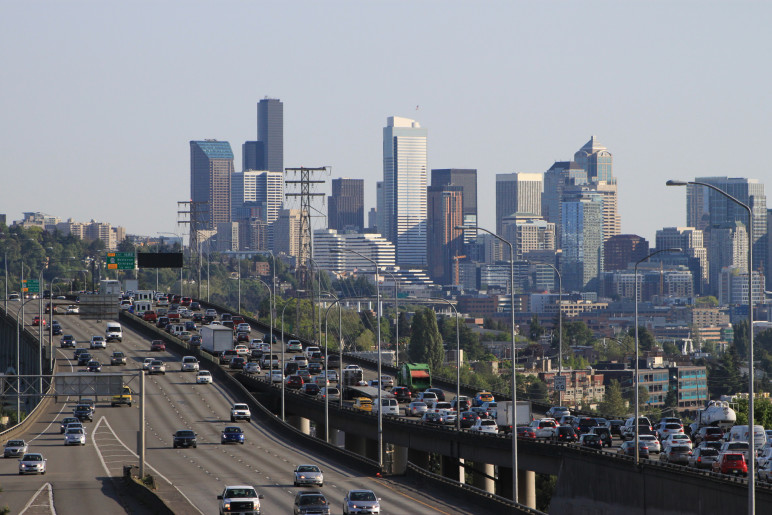When New York Mayor Michael Bloomberg first endorsed congestion pricing in 2007, it failed to even advance to a State Assembly vote. It was new, it was bold, and it was a nonstarter.
But in March 2019, after more than 10 years of advocacy from environmentalists and transit activists, New York became the first US city to approve a plan to charge for access to busy urban roads during particular hours. State officials agreed they want the anti-congestion scheme to raise $1 billion a year, starting in 2021, to improve a degrading transit system.
More than an infrastructure breakdown was needed to turn public opinion around and motivate elected officials.

As major Cascadian cities consider similar policies—Seattle, Portland and Vancouver, BC, have all been formally discussing congestion pricing—it’s worth asking: How did New Yorkers get there?
Activists who had been involved since the beginning knew that congestion pricing faced a slew of political challenges. It’s never easy to convince elected officials to start charging a new fee on driving. For years, polls came up with different conclusions on how popular congestion pricing had actually been among New Yorkers, but in almost every poll, a majority was opposed.
But in 2017, something changed: New York’s public transit infrastructure hit a breaking point. In two years, the average number of subway delays per month shot from 25,000 to 75,000. Congestion was so bad, the estimated average speed for people driving through midtown Manhattan was barely faster than walking.
More than an infrastructure breakdown was needed to turn around public opinion and motivate elected officials, however. Here are the five ways advocates made critical progress and created an example for cities in Cascadia and beyond to follow.
1. Name and shame specific elected officials
In 2015, the transit advocacy group Riders Alliance began toting a life-size cardboard cutout of New York Governor Andrew Cuomo on the train for riders to share their frustrations about delays. In 2017, the organization tightened the screws, unleashing social media campaigns and bringing subway riders’ horror stories directly to the executive as he prepared to launch a re-election bid.
“It was so obvious that our subways and buses, that our public transit system was falling apart, and pretty rapidly,” said Rebecca Bailin, political director at the Riders Alliance. “Political accountability was 80 percent of the battle for us.”
But congestion pricing, blocked by legislators 10 years before, still had a long way to go before earning state elected officials’ support. Organizers took a two-pronged approach: While Riders Alliance’s grassroots movement brought riders’ stories to politicians, groups such as the Regional Plan Association, Tri-State Transportation Campaign, and Environmental Defense Fund worked behind the scenes to gather votes.
February 2019 marked a major victory for transit advocates: Cuomo and New York Mayor Bill de Blasio came out in support of congestion pricing.
2. Bring the data that builds your coalition
Sometimes, all it takes to build some support is a bit of fact finding.
“It is absolutely clear that the data spoke in favor of congestion pricing,” said Andy Darrell, executive director of the Environmental Defense Fund.
If a toll on downtown Manhattan were to succeed, it also needed to overcome public perception that it was a regressive tax—that, as a flat fee, it disproportionately affected low-income vehicle drivers more than their wealthy counterparts.
For years some of the toughest foes of congestion pricing were state legislators who represented Gotham’s other four boroughs, where residents were being priced out farther from New York’s Manhattan core.
Again, advocacy groups met that opposition with data—and when that didn’t work, loud voices.
How many New Yorkers would actually be impacted by the fee? Just 4 percent of outer-borough residents drive to work in Manhattan, according to an October 2017 Community Service Society report. And only 2 percent of the working poor would be charged by the toll, the analysis said.
New York Assemblywoman Rodneyse Bichotte (D- Brooklyn) had used the concern for low-income drivers to justify her opposition. But just 1.9 percent of Bichotte’s constituents would suffer from the proposed fee, according to US Census estimates used by the Tri-State Transportation Campaign.
Bichotte was one of two Assembly officials who still opposed the policy by March 24. When the two held a news conference to explain their stance a week before the state budget deadline, dozens of protesters —including labor groups — crashed the conference and made their support for congestion pricing known. Two days later, those same politicians announced an about-face and supported the policy.
“Often what happens in any issue is, people who have the most privilege are the ones elected officials are hearing from,” Bailin said.
3. Find a popular way to spend the money
Data alone wasn’t enough. Advocates said state officials also needed to believe that the money would go to improvements for their constituents. Earmarking funding for specific transit upgrades became an essential part of securing those votes, said Kate Slevin, senior vice president of state programs and advocacy at the Regional Plan Association.
Improved public perception of the Metropolitan Transportation Authority and measures to improve its accountability also helped secure votes, advocates said. Alex Matthiessen, president of the Blue Marble Project, was involved in trying to get congestion pricing passed since 2010 and attributed the MTA’s improved credibility to a new transit official, Andy Byford.
Legislators who eventually supported congestion pricing believed “that by taking this vote, they would actually deliver the revenue that would be beneficial to these communities,” said Darrell of Environmental Defense Fund. “With this vote their constituents would actually see an improvement in their quality of life.”
Polls in earlier, failed campaigns for the scheme showed the same trend. When polls included a detailed description on where the money would go, congestion pricing polled better.
A 2014 poll showed the public was more likely to support congestion pricing if that money was used to improve roads and bridges, reduce tolling on bridges outside of Manhattan, and increase express bus services. When those polled were informed of those possibilities, support jumped from 42 to 56 percent.
4. Bring examples of success stories elsewhere
Darrell said he also believed the success stories of congestion pricing in other major cities around the world—London, Stockholm, and Singapore—helped make the case in New York. And congestion pricing has a variety of strong selling points, from congestion relief for business to reducing emissions to avoiding expensive highway expansions. As other cities struggle with population growth, tolling downtown cores could gain adherents.
5. Build your coalition
Showing that the policy will advance coalition members’ goals became key to congestion pricing’s success.
The New York City’s Environmental Justice Alliance, for example, pointed out that the transit crisis disproportionately affected communities of color. Workers struggled to get to their jobs with a dysfunctional subway system, and in the last weeks before the legislators finished the state budget, labor unions stepped off the sideline to flex their political muscle.
Business organizations, such as Partnership for NYC, and rideshare companies also supported the policy because they had long been frustrated with the gridlock. (New York state and city officials had previously considered implementing fees only on rideshare companies.) A January 2019 report by Fix NYC concluded that congestion had steadily worsened since 2012.
Could Seattle be next?
In New York City, it took a transportation crisis before elected officials acted on congestion pricing. But Bailin and Transportation Choices Coalition’s Hester Serebrin say Seattle could be especially receptive to action to reduce carbon emissions. Seattle Mayor Jenny Durkan announced her support for congestion pricing early in her term, in April 2018, as part of a larger plan to address climate change.
Durkan has set a goal of implementing congestion pricing by 2021, the end of her first term, and recently set aside $1 million in the city’s two-year budget to study its viability.
Serebrin said she thinks it’s important to engage residents to identify gaps in transit service — echoing Durkan’s announcement in April 2018 that the city must “engage people deeply” to pair congestion pricing with meaningful alternatives to traveling by personal car.
In practice, that commitment mostly means frequent buses that can travel long distances quickly, thanks to dedicated lanes and signals that cut them a green path through busy streets.
“Wherever you are in America, the most vulnerable people are on the bus systems,” said Slevin of the Regional Plan Association. “I think there’s a way to implement congestion pricing that could address those equity concerns.”
Though Seattle has taken initial steps and set a goal for implementation, the city can still draw lessons from New York going forward. Those who were involved in New York’s push showed the way to build coalitions, disseminate data and details on how the money would be spent, and provide other success stories. And there certainly will be variables for Seattle and other Cascadian cities considering congestion pricing, but New York’s implementation shows that it can be done.
Hayat Norimine is a freelance journalist recently living in the Seattle area who reports on politics. Previously, she worked at Seattle Met magazine. She graduated from the Medill School of Journalism and the University of Washington.












Kyle M
Does Seattle need legislative authority to move this forward (hopefully not!) ?
asdf2
In spite of the historic vote, declaring victory now feels premature. There is still time for politicians to bow to pressure from the automotive lobby and either reverse their vote, or add so many exemptions as to render congestion pricing effectively meaningless. There is also the possibility of congestion pricing being challenged in court.
I’ll consider it victory when the tolls are actually being collected, and subway commuters are enjoying service improvements that the tolls are paying for. At that point, removing the tolls becomes much more difficult.
Still an important first step, though.